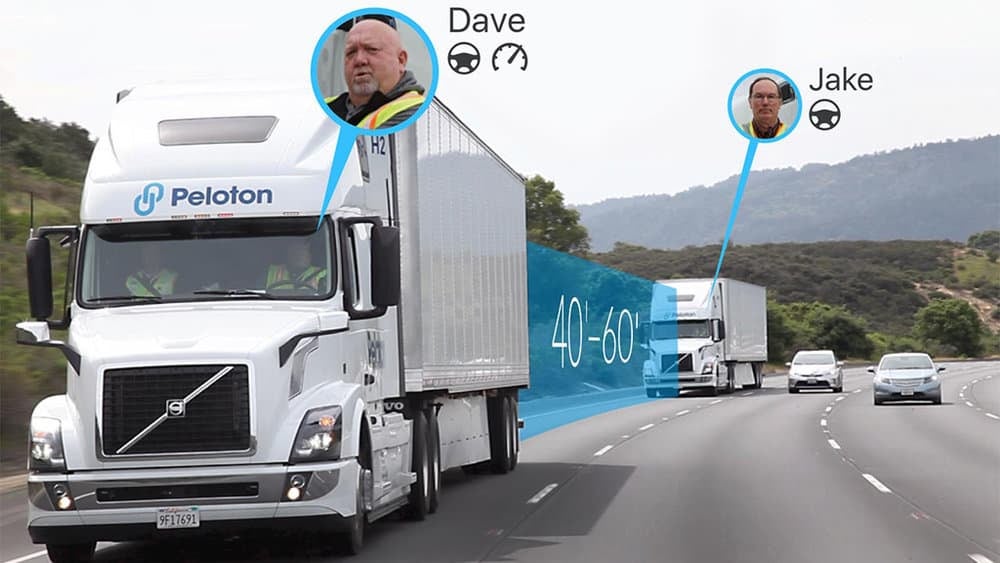
Peloton Technologies is running several ongoing tests of its platooning system, which its chief marketing officer referred to as something akin to “advanced cruise control.”
There are no full commercial users of the technology, which would allow a group of trucks—two for now, presumably more in the future—to travel with tight spaces between the vehicles, saving on fuel and creating other efficiencies. But Rod McClane, in an interview with FreightWaves, said California-based Peloton Technologies is running several pilot programs with various fleets, with the aim of having full commercial operations at its first customers sometime next year.
Pelton Technologies is the number 17 company in the inaugural FreightTech 25, a ranking of the most technologically cutting-edge companies in the trucking and transport world.
McLane described the current technology as being a “level 1 automation system.” Through the technology at this point, the driving work is being done by the truck in the front. The following truck is being governed by the Peloton Technologies system, managing the speed and most importantly, the braking of the second truck. If the truck in the front hits the brakes, the system sends that information to the second truck in a nanosecond and the brakes are engaged at a far quicker speed than the human ability to register what happened and move the foot from accelerator to brake pedal. With that human imperfection replaced by automation, it enables trucks to follow at a range of as close as 55 feet apart. Normally, the distance could be either side of 300 feet.
“It’s been on the roads for the whole second half of 2018,” McLane said. “These pilot programs are effectively hauling freight using the technology with these customers.”
The testing that has occurred on the roads follows several years of on-track tests of the platooning system. It has only been since mid-year that the company has been road testing the technology, McLane said. Peloton Technologies is not yet disclosing the names of any of the companies that are testing its system, he added. Of the top 25 fleets in the country, McLane said Peloton Technologies is “actively engaged” with a “good percentage” of them “in one way, shape or form.”
At present, the fuel savings are the “big carrot.” The fuel savings overall, according to McLain, is about 7 percent across two platooning trucks. The rear trucks gets about 10% in fuel savings, while even the front truck, due to reductions in the front truck’s drag, sees its fuel consumption drop by about 4%.
But McLane said the safety aspects are a very close second. He said that testing is showing that the reactionary braking on the second truck is so minuscule that when Peloton Technologies is doing what he called a “panic stop,” the gap between the front and the back truck have barely moved.
McLane contrasted the early limited tests of what Pelton Consulting is doing with the work being done by companies such as Waymo. They are focused even now on what he called a “higher level,” a fully autonomous vehicle or at least greater degrees of autonomy. “Our approach was to look at a solution that was a lower level than that but that would be something deployable today,” he said.
The Waymo way of looking at “higher automation” does involve the potential elimination of drivers. Peloton Technologies is not at that point yet, but platooning “can be used to address certain cases,” McLane said. He added that the company envisioned some situations where the platooning technology could reduce the need for a driver in some of the trucks in the platoon, but that he looks at it “conceptually.”
Before that level is reached, there are more pedestrian concerns. For example, McLane said there are a little less than 20 states that have changed their laws to allow platooning, so that two vehicles traveling that closely would be legally permissible. Under the old laws, the back vehicle could be cited for following too closely.
With the focus now on one truck following the other, and the question of eliminating drivers completely further down the road, what are the next steps? McLane said a “relatively easy one” would be extending the number of vehicles in a platoon. Cross-platform operations would be another goal, where two trucks from different companies could utilize the technology to platoon. They’re all connected to the Peloton Technologies cloud technology. And collecting reams of data that can then be used for maximizing fleet efficiency—which all technologies today are seeking to do—is another possible course of action for Peloton Technologies.
Peloton Technology is likely to have another round of funding sometime during calendar 2019, McLane said. Funding has come from traditional sources like the venture capital community, but he also identified “strategic” investors such as UPS, BP and Schlumberger.
With that funding in place, there’s lots to be done beyond what Peloton Technologies has accomplished so far. “We look at the technology we’ve deployed as really being kind of the foundation,” McLane said. “That was always our approach.”







